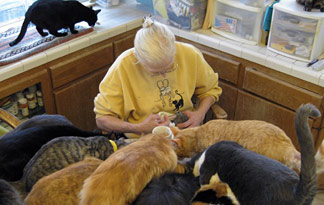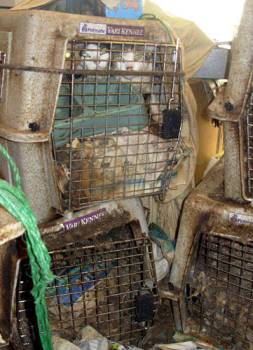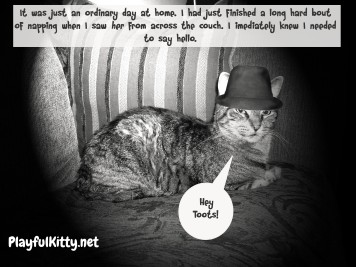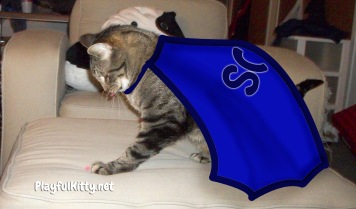Think that you know an animal hoarder? Perhaps it is a friend or family member. It could even be the person who lives in that disheveled house you pass on your way home from work. You don’t have to sit in silence and watch all of those animals suffer neglect.
Why Should I do Anything?
Especially if you don’t have a personal relationship with the animal hoarder it may seem awkward to intervene. You may feel like it is none of your business and you should stay out of it. Here are a few compelling reasons for you to take action:
- Taking action could save the lives of the animals. Animals living in these conditions are starving, sick, injured, and traumatized. Just think of the 250,000 animals who are victims of animal hoarding every year. Imagine the hero you could be to them!
- Taking action could save the lives of the animal hoarders themselves. The humans living with these animals often live in the same filth and squalor as the animals do. How can they possibly be physically and mentally healthy? If this person is a friend or family member, do you really want them living this way?
- Animal hoarders rarely seek help on their own. The animal hoarding situation is only going to get worse the longer it goes on. This is not the kind of situation that will just go away if you ignore it. That house down the street will just smell worse and worse everyday.
You can make a difference for the animals, the animal hoarders, and for your community. Just follow these steps.
Step 1: Observe and Record Animal Hoarding Behaviors

Photo courtesy of Confessions of an Animal Hoarder
First things first, you want to be sure that the person you believe to be an animal hoarder really is an animal hoarder. If you missed it Animal Hoarders Part 1: Identifying An Animal Hoarder gives a definition and some signs of animal hoarding. Not everyone who has a lot of pets is an animal hoarder. If the person has a lot of pets but they are well cared for, then the person is not an animal hoarder.
Take a good look at the animals and their surroundings. If the animal hoarder will allow you, go into their house and their yard to see the conditions. Is the house reasonably clean or are they living in squalor? Do the animals look well fed, groomed, well-socialized and otherwise healthy? Do the animals look sick, emaciated, or unusually scared? Are the animals always confined to cages? Is adequate food and water provided? Take note of everything that doesn’t seem right to you. This information will make it clear to you whether or not the person is able to care for the number of pets they have or not. Should you need to call the authorities on the animal hoarder, they will want to know what you’ve observed.
Step 2: Talk to the Animal Hoarder
It is hard to say without talking to the animal hoarder, just how aware they are of their problem. Most animal hoarders believe that they are helping the animals in their care despite all of the evidence that would seem so obviously contrary to anyone else. You (or someone who knows the animal hoarder better than you do) need to calmly talk to them about their situation. Chances are that they will be very defensive; don’t try to argue with them. Remember that these are real people with real feelings. They may be very good people deep down inside who are suffering from a serious mental illness (animal hoarding). Try not speak negatively about them, but rather, talk about how much easier life would be for them if they had fewer animals. Another approach would be to talk about how much better the lives of their animals would be if they could have access to proper nutrition, veterinary care, etc.
The goal of talking to the animal hoarder is to make them aware of their situation and to try to get them to agree to get help. While the study of animal hoarding as a mental illness is still very new, there are some treatment options. You can find a therapist in your area that specializes in helping hoarders by visiting the websites of mental health organizations such as Anxiety Disorders Association of America (ADAA) or International OCD Foundation (IOCDF). If and when a plan for treatment is made with the animal hoarder, be sure to follow up and see that they have complied with the plan.
Tip: Don’t try to help this animal hoarder on your own. Get friends, family, and community members of the animal hoarder as well as mental health professionals, animal rescue organizations, etc to assist you.
Step 3: Rescue the Animals

Photo courtesy of vetmedicine.about.com
If the animal hoarder has agreed to allow the animals to be removed, all you need to do is solicit the help of an animal rescue organization to help you out. The more animals there are, the more help you will need. Make sure that the animal hoarder also receives treatment for their illness, because without that continuing treatment almost 100% of animal hoarders begin hoarding again.
You may not be lucky enough to have the animal hoarder agree to have the animals removed. Animal hoarders can be very stubborn about their hoarding. In this case, you will have to call authorities to have the animals removed. This may be a very difficult thing for you to do -especially if the hoarder is someone you really care about. Be assured that it is the right thing to do. If you call your local police, humane society, or animal control shelter they can take firm action to remove the animals and force the animal hoarder to get the help that they need. Your local animal rescue groups may have some good resources for you as well. If you would like legal advice on an animal hoarder you could contact the Animal Legal Defense Fund (ALDF) by visiting their website, calling 707-795-2533, or emailing them at action1@aldf.org .
What Will Happen In Court
Animal hoarding cases are very difficult to prosecute because most states don’t have legal definitions for animal hoarding. There are only 2 states with a legal definition for animal hoarding. In all other states animal hoarding is vaguely covered under animal cruelty laws. It can be difficult to make the charges stick.
If a person is convicted of animal hoarding, the Humane Society of the US pushes for the following sentence requirements:
- Mandatory psychological testing.
- Limits on the number of animals the person can own (no more than 2).
- Lengthy probation periods so that the courts can make sure that the person continues treatment.
- Random home visits from the probation officer during the probationary period to see that the person has not begun re-hoarding.
- If the case is severe enough, the HSUS will even pursue jail time.
Step 4: Be a Part of the Lasting Solution
Removing the animals and seeking treatment is only the beginning of the journey for the animal hoarder. The event of having the animals taken away will no doubt be very traumatic for them. It will be very hard for them to change their ways. They will need all of the support that they can get. You don’t have to spend all day, every day with them, but even just stopping in to see how they are doing every now and again can help. If you have a close enough relationship with them, help them to get to their therapy and doctor’s appointments. Help them find new things to do with all of the time they aren’t spending chasing after animals anymore. Let them know that you care about them.










